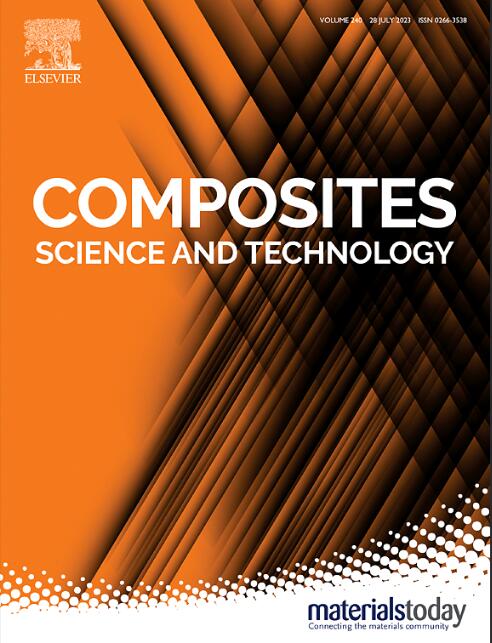Interlaminar toughness of carbon fiber/epoxy laminates interleaved by nanofibrous veils: from molecular structure to macroscopic properties
IF 8.3
1区 材料科学
Q1 MATERIALS SCIENCE, COMPOSITES
引用次数: 0
Abstract
Nanofibrous veils with nanometer-scale diameters and continuous lengths are considered promising interlayers for enhancing the interlaminar toughness of continuous fiber-reinforced polymer matrix laminates (CFRPs). The molecular structure of nanofibers is a crucial factor influencing their toughening performance, but the underlying trans-dimension structure-activity relationship remain unclear. Here, two types of polyamide-based nanofibrous veils (NF1 and NF2), characterized by distinct molecular structures, were integrated into carbon fiber/epoxy laminates to assess differences in interlaminar fracture toughness. Mode I and Mode II loading tests demonstrated significant yet distinct improvements in interlaminar fracture toughness for the two nanomodified CFRPs, attributed to intrinsic and extrinsic toughening mechanisms. NF1-modified composites exhibited superior toughening properties than NF2-modified composites, with a 186 % enhancement in GIC and a 134 % enhancement in GIIC. This superiority can be attributed to NF1's higher crystallinity, smaller diameter, stronger tensile strength, and greater interaction energy with epoxy resin, all of which are closely related to the molecular structure of the nanofibers. Molecular dynamics (MD) simulations provided theoretical insights into how the molecular structure of nanofibers influences interlaminar toughness. Furthermore, the original laminate static flexural properties, dynamic stiffness, and glass-transition temperature (Tg) are all maintained for NF1-modified composites, suggesting that enhancing interlaminar toughness can compensate for potential declines in mechanical and thermomechanical properties. Consequently, the multi-level structure-activity relationship between polymer molecular structure, nanofiber morphology, interlaminar topology, and composite macroscopic properties was established to pave the way for precise atomic-level construction of interlaminar structures in laminates.

纳米纤维膜交织碳纤维/环氧层压板的层间韧性:从分子结构到宏观性能
具有纳米级直径和连续长度的纳米纤维面纱被认为是提高连续纤维增强聚合物基层合板(CFRPs)层间韧性的有前途的中间层。纳米纤维的分子结构是影响其增韧性能的重要因素,但其跨维构效关系尚不清楚。本研究将两种分子结构不同的聚酰胺基纳米纤维膜(NF1和NF2)整合到碳纤维/环氧层压板中,以评估层间断裂韧性的差异。模式I和模式II加载试验表明,由于内在和外在增韧机制,两种纳米改性cfrp的层间断裂韧性有了显著而明显的改善。nf1改性复合材料的增韧性能优于nf2改性复合材料,GIC增强了186%,GIIC增强了134%。NF1具有较高的结晶度、更小的直径、更强的抗拉强度以及与环氧树脂更大的相互作用能,这些都与纳米纤维的分子结构密切相关。分子动力学(MD)模拟为纳米纤维的分子结构如何影响层间韧性提供了理论见解。此外,nf1改性复合材料的原始层压板静态弯曲性能、动态刚度和玻璃化转变温度(Tg)都保持不变,这表明增强层间韧性可以弥补机械和热机械性能的潜在下降。因此,建立了聚合物分子结构、纳米纤维形态、层间拓扑结构和复合材料宏观性能之间多层次的构效关系,为层合板中层间结构的精确原子级构建铺平了道路。
本文章由计算机程序翻译,如有差异,请以英文原文为准。
求助全文
约1分钟内获得全文
求助全文
来源期刊

Composites Science and Technology
工程技术-材料科学:复合
CiteScore
16.20
自引率
9.90%
发文量
611
审稿时长
33 days
期刊介绍:
Composites Science and Technology publishes refereed original articles on the fundamental and applied science of engineering composites. The focus of this journal is on polymeric matrix composites with reinforcements/fillers ranging from nano- to macro-scale. CSTE encourages manuscripts reporting unique, innovative contributions to the physics, chemistry, materials science and applied mechanics aspects of advanced composites.
Besides traditional fiber reinforced composites, novel composites with significant potential for engineering applications are encouraged.
 求助内容:
求助内容: 应助结果提醒方式:
应助结果提醒方式:


